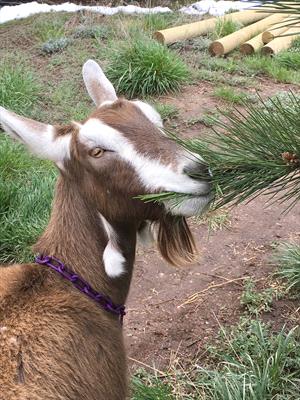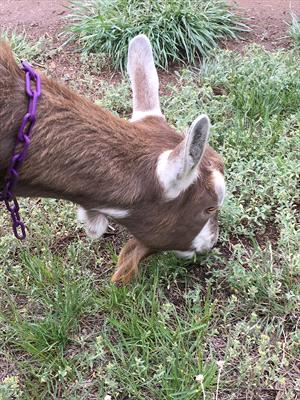Goat Eating Pine

This goat is eating pine. Photo by Breanna Foley.
For reasons that aren’t at all clear, the goat has been the victim of some of the most pernicious animal husbandry myths that a technological age can provide. Several factors conspire against the caprine creatures (dogs are canine, cats are feline, sheep are ovine, and goats are caprine).
Goats are classified as a minor species. This designation has nothing to do with age and everything to do with money. Goats and sheep are not major economic elements in U.S. livestock production. From the perspective of the pharmaceutical companies, this means that goats and sheep aren’t worth many research dollars. There are very few (less than a handful in common use) drugs or vaccines that are federally labeled for use in goats. No big, bad pharma to get in the way. Goat husbandry can remain pure.
Unfortunately, whether we like it or not, most owner-education resources in the livestock and pet industries are driven by drug dollars. This is the reason that you don’t see a lot of glossy goat-wellness flyers or “Vaccinate your Goat” campaigns. Who profits? In this case, only the goat, and he isn’t footing the bill.
Sadly, goats lack an identity. In the U.S., people are often confused about goats. Though goat meat is becoming more popular in some regions, it tends to be off the radar for the bulk of Americans. Ditto goat milk. I have talked to people who were actually confused when informed the goat milk sold in cardboard quarts in the grocery store is the same stuff as cow's milk. And only the miniscule community of fiber artists grasps that goats produce hair - mohair or cashmere - that can create clothing. However, despite our cultural confusion regarding goats, they have been raised as livestock for centuries.
On wild animal documentaries, we see wild goats living in deserts and impossible, rocky crags where the only growing thing seems to be a small scum of lichen, and we presume that goats can survive on anything.
Welcome to the 21st century and the advent of a new creature – the PET goat! Pet goats have the same basic needs as the commercially raised kind, but from a veterinary standpoint, they represent a whole new ball game. This brings me to the next issue in goat mythology.
The Internet
Perhaps sensing a degree of uncertainty on the part of veterinarians trying to come to grips with the notion of a client willing to pay $1200 for a fracture repair on a $60 goat, goat groups and chat rooms have sprouted like mushrooms. Some of these groups, particularly those affiliated with college or county agricultural extension offices or with official breed organizations, can be quite good. However, there are goat sites out there that make YouTube and Facebook look like paragons of sourced journalism.
Goat Breeders
I hate to say this, because I have no desire to paint all who raise goats with the same brush. However, I have had clients come to me with some of the most extraordinary notions about caring for their goats. When questioned, these same clients routinely swear up, down, and sideways that they are faithfully following the instructions of the breeder.
The Omnivorous Goat
Without a doubt, this is the mother of all goat myths. This creature has several variants: the goat that won’t eat poisonous plants because of instinct, the goat that can eat anything including table scraps and tin cans, and the goats that apparently don’t need to be fed because they draw nutrition from the aura of a dirt pasture.
Without fail, nearly every time I have opened my mouth to utter “Let’s talk about nutrition” to a goat owner, I have been greeted with the response, “But goats can eat anything, can’t they?”
No, they cannot “eat anything.” In the broadest designation, goats are herbivores. Translation: they eat plants, not tin cans; not animal products; and not Twinkies. More specifically, goats are ruminants. Like cattle, they have a four-chambered stomach. The rumen, the largest compartment, contains microbes that ferment the plant material and break down the plant fiber into volatile fatty acids (VFAs) that are the beneficial nutrients. In essence, when you put food in front of your goat, you are not feeding the goat, you are feeding the bacteria. Even more specifically, unlike cattle and sheep, goats are browsers not grazers. This means that they are adapted to eat leaves and brush rather than grasses. This last trait explains why a child's 4-H goat ignores the lush lawn and decimates rose bushes.
Of these caprine dietary habits, possibly the one that most defines a goat’s menu options is its ruminant status. Remember, we are feeding the bacteria living in the goat’s rumen. Those bacteria like consistency and they do NOT like changes. Certain dietary changes unfortunately tend to drop the rumen pH (a measure of acidity and alkalinity) and make it more acidic, causing havoc among the bacteria who are now dying by the millions. These changes tend to be from the things that the goat likes and that humans think are nice: extra grain, feeding all grain or pellets when you run out of hay, dumping a load of grass clippings, old vegetables, or other landscaping remains into the goat pen, switching from grass hay to green alfalfa.
While goat nutritional needs vary depending on breed, age, use, and breeding status, there are some general guidelines that apply across the board.
Maintain consistency
Those bacteria are set in their ways and respond poorly to sudden changes of any kind. If you need to switch forages or to add a concentrate (grain, etc.) to the diet, it is best to make the changes gradually over several weeks.
Forage
Healthy rumen function relies upon a certain fiber length; the fibers of hay or plant stems rub on the rumen’s lining and promote the contractions that maintain a healthy environment for the bacteria. While there are commercially available pelleted “complete” feeds formulated for goats, these feeds alone do not provide the adequate fiber length to stimulate rumen contraction. Generally speaking, about 90 percent of a goat’s diet should come from forage, such as hay, pasture, random non-toxic brush, etc.
Faline Eating in a Pasture

Photo by Breanna Foley
Avoid Over-Feeding
The nature films get the goat environment right. Think about it; when did you last see photos of wild goats roaming green fields? Goats can survive quite well on relatively low planes of nutrition.
Feed Them
Previous statement notwithstanding, goats DO actually have to eat something. They cannot be “thrown out on the back 40 to fend for themselves.” Keep them away from toxic plants. While goats are more resistant to some plant toxins (yellow star thistle, for example) than many other species, they are not poison-proof. Young or very hungry animals will eat toxic plants, and several of our common landscaping plants, such as oleander and azalea, can be deadly.
The Disease-Proof, Maintenance-Free Goat
Another myth is that goats are disease- and parasite-proof. Goats are animals, not superheroes.
Goats are susceptible to various internal and external parasites and to bacterial and viral diseases. They require strategic vaccination and deworming programs, just like any other animal. Goats also require regular hoof care, and occasionally even dental care.
One of the weirder myths out there - and not specific to goats, by any means - is the “We don’t need to worry about castrating him because he won’t mate with his sister” myth.
I hate to be the one to burst the innocence bubble, but goats and other animals don’t have incest taboos. A male goat in rut will quite happily mount anything that doesn’t get out of his way. Whether he’s her brother or not, a doe in heat will stand quite happily for anything that smells good.
If you have more than one goat of opposite genders, assume you will have small goats in about 5½ months. If you do not intend to become a goat breeder, the best option for population control is to separate the male goat from his testicles. Side benefits: he will smell much better, be less inclined to destroy fences, and will generally be easier to handle. Downside: he will be more prone to urinary tract obstruction.
Goat mythology, while entertaining, does not typically benefit the species. If you are contemplating gettng goats as pets, check with your veterinarian to verify a willingness to treat goats, as many don’t, or refer you to one who does. Your goat’s veterinarian can give you recommendations for diet, vaccination, and parasite control for your area. Research the breed of goat you are acquiring. Learn whether it is susceptible to any particular diseases. If you are planning to breed goats, learn about the reproductive characteristics of that breed: Is it a good milker? Are there genetic conditions? Is there a high rate of difficult birthing? (This last bit is a problem in dwarf breeds.)
Like anything else in life, raising goats takes information, work, and luck. If anyone says differently, it’s a myth.